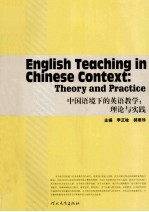

中国语境下的英语教学 理论与实践PDF电子书下载
- 电子书积分:12 积分如何计算积分?
- 作 者:李正栓,郝惠珍著
- 出 版 社:石家庄:河北教育出版社
- 出版年份:2009
- ISBN:9787543474482
- 页数:324 页
Preface 1
Chapter 1 English Teaching in Chinese Context 1
1.1 Present Situation of English Teaching in China 1
1.2 Problems of English Teaching in China 3
1.3 English Teaching in the 21st Century 5
1.4 Summary 8
Chapter 2 Relevant Theories 9
2.1 Theories of Language 9
2.2 Theories of Learning 13
2.3 Summary 20
Chapter 3 The National English Curriculum 22
3.1 Essence of the National English Curriculum 22
3.2 Principles of the National English Curriculum 23
3.3 Theories of the National English Curriculum 25
3.4 Reform Focus of the National English Curriculum 30
3.5 Goals of English Language Teaching 31
3.6 Different Levels of Competence According to the Curriculum 32
3.7 Difference Between Syllabus and Curriculum 34
3.8 Summary 38
Chapter 4 Historical Overview of English Teaching Since Liberation 40
4.1 Historical Periods of English Language Teaching 40
4.2 Theoretical Periods of English Language Teaching 48
4.3 Summary 59
Chapter 5 Methods and Approaches to English Teaching 62
5.1 The Grammar-Translation Method and the Direct Method 62
5.2 The Oral Approach and the Audio-Lingual Method 70
5.3 The Natural Approach 74
5.4 The Interactive Language Teaching 76
5.5 The Communicative Approach 79
5.6 Task-Based Instruction 82
5.7 Other Teaching Methods 86
5.8 Summary 95
Chapter 6 Methods and Approaches to English Learning 97
6.1 Cooperative Language Learning 97
6.2 Experiential Learning 104
6.3 Inquiry Learning 109
6.4 Summary 117
Chapter 7 The Integrated Approach in Chinese Context 119
7.1 Definition of the Integrated Approach 119
7.2 Necessity of Integration in Chinese Context 120
7.3 Development of the Integrated Approach 122
7.4 Theories of the Integrated Approach 124
7.5 Features of the Integrated Approach 131
7.6 Principles of the Integrated Approach 132
7.7 Contents of Integration 133
7.8 Models of the Integrated Approach 136
7.9 Implementation of the Integrated Approach 138
7.10 Summary 139
Chapter 8 Teaching Language Skills 141
8.1 Teaching Listening 142
8.2 Teaching Speaking 144
8.3 Teaching Reading 147
8.4 Teaching Writing 150
8.5 Teaching Translating 152
8.6 Teaching English Songs 155
Chapter 9 Teaching Language Knowledge 162
9.1 Teaching Pronunciation 162
9.2 Teaching Grammar 168
9.3 Teaching Vocabulary 172
9.4 Teaching Culture 176
Chapter 10 Teaching Language Learning Strategies 179
10.1 Introduction to Language Learning Strategies 179
10.2 Characteristics of Language Learning Strategies 180
10.3 Types of Language Learning Strategies 181
10.4 Teaching Language Learning Strategies 183
10.5 Summary 186
Chapter 11 Cultivating Morality in English Teaching 187
11.1 What Is Morality? 187
11.2 Morality Is Culture-Specific 188
11.3 Cultivating Morality Is Psychologically Feasible 188
11.4 Cultivating Morality Is Educationally Necessary 189
11.5 Use of Language Teaching Materials 190
11.6 Activities of Moral Education 191
11.7 Tips for Cultivating Morality 192
11.8 Summary 192
Chapter 12 Multimedia-Assisted English Language Teaching 193
12.1 Definition of Multimedia 193
12.2 Stages of the Development of Multimedia-Assisted Language Teaching 193
12.3 Advantages of Using Multimedia in English Language Teaching 195
12.4 Ways of Using Multimedia in English Language Teaching 197
12.5 Tips for Using Multimedia in English Language Teaching 200
12.6 Summary 201
Chapter 13 Classroom Management 202
13.1 Routines of a Lesson 202
13.2 Patterns of Classroom Interaction 205
13.3 Troubleshooting 211
13.4 Discipline in the Language Clsasroom 212
13.5 Using Teaching Aids 213
13.6 Correction of Mistakes 218
13.7 Evaluation of a Teacher's Lesson 221
13.8 Summary 228
Chapter 14 Lesson Planning 229
14.1 What the Teacher Should Know 229
14.2 The Nature of Lesson Plans 233
14.3 Format of a Lesson Plan 234
14.4 Teaching Aids 238
14.5 Predicted Problems and Solutions 239
14.6 Evaluation 240
14.7 Guidelines for Lesson Planning 240
14.8 Individual Differences in Lesson Planning 242
14.9 Principles of Lesson Planning 245
14.10 Questions to Ask 245
14.11 The Plan 247
14.12 Sample Lesson Plan 249
14.13 Summary 262
Chapter 15 Learning Style and Teaching Style 264
15.1 Learning Styles 264
15.2 Teaching Styles 266
15.3 Adjusting Teaching Styles to Students' Learning Styles 267
15.4 Summary 268
Appendix(VAAK Questionnaire) 269
Chapter 16 Reflective Language Teaching 272
16.1 Introduction 272
16.2 The Moments of Reflective Language Teaching 273
16.3 Contents of Reflective Language Teaching 274
16.4 Process of Reflective Language Teaching 275
16.5 Methods of Reflective Language Teaching 277
16.6 Benefits of Reflective Language Teaching 281
16.7 Summary 282
Chapter 17 Action Research 284
17.1 Definition of Action Research 284
17.2 Significance of Doing Action Research 285
17.3 Features of Action Research 286
17.4 Process of Action Research 287
17.5 Methods and Techniques for Action Research 288
17.6 Example of an Action Research 292
17.7 Points to Take into Consideration 293
17.8 Summary 293
Chapter 18 Assessment of Students' Achievement 295
18.1 Test,Measurement,Evaluation,and Assessment 295
18.2 Tests 297
18.3 Purpose of Assessment 301
18.4 Principles of Assessment 302
18.5 Assessment of Students' Language Proficiency 304
18.6 Summary 315
Appendix(Bibliography) 316
- 《SQL与关系数据库理论》(美)戴特(C.J.Date) 2019
- 《高级英语阅读与听说教程》刘秀梅编著 2019
- 《思维导图 超好用英语单词书》(中国)王若琳 2019
- 《联吡啶基钌光敏染料的结构与性能的理论研究》李明霞 2019
- 《培智学校义务教育实验教科书教师教学用书 生活适应 二年级 上》人民教育出版社,课程教材研究所,特殊教育课程教材研究中心编著 2019
- 《情报学 服务国家安全与发展的现代情报理论》赵冰峰著 2018
- 《英汉翻译理论的多维阐释及应用剖析》常瑞娟著 2019
- 《初中生英语作文 提高篇》清瑶主编 2019
- 《指向核心素养 北京十一学校名师教学设计 英语 七年级 上 配人教版》周志英总主编 2019
- 《培生高级英语语法 练习册》培生教育 2019
- 《培智学校义务教育实验教科书教师教学用书 生活适应 二年级 上》人民教育出版社,课程教材研究所,特殊教育课程教材研究中心编著 2019
- 《习近平总书记教育重要论述讲义》本书编写组 2020
- 《办好人民满意的教育 全国教育满意度调查报告》(中国)中国教育科学研究院 2019
- 《教育学考研应试宝典》徐影主编 2019
- 《语文教育教学实践探索》陈德收 2018
- 《家庭音乐素养教育》刘畅 2018
- 《学前教育学》王换成主编 2019
- 《近代体育游戏教育史料汇编 第1辑 1》王强主编 2016
- 《全国学前教育专业(新课程标准)“十三五”规划教材 简谱手风琴教程 第2版》(中国)杨克勤,王宝庆 2019
- 《现代教育技术》李志河主编 2019
